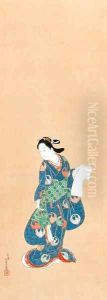Kaweda Toyonobu Paintings
Kaweda Toyonobu was a prominent Japanese artist, known for his contributions to the ukiyo-e genre of woodblock prints and paintings. Born in 1711, Toyonobu was active during the Edo period, a time when the ukiyo-e style flourished in Japan. This artistic genre, centered around the fleeting world of the common people, including subjects such as kabuki actors, sumo wrestlers, geishas, and scenes from history and folklore, provided a vivid account of the cultural life in Japan during this era. Toyonobu's works are celebrated for their dynamic compositions, delicate lines, and the infusion of a sense of elegance and grace.
Toyonobu began his career as a pupil in the studio of Nishimura Shigenaga, a well-regarded artist of the time, and later came to establish his own distinctive style. His ability to blend the traditional with innovation made his works highly sought after, especially his actor prints and bijinga (pictures of beautiful women). Toyonobu was also instrumental in the development of the benizuri-e style, a precursor to full-color nishiki-e prints, which involved the use of one or two additional color blocks in printing. This technique added vibrancy to his creations and marked a significant step in the evolution of ukiyo-e towards more colorful compositions.
Beyond his artistic achievements, Toyonobu's legacy includes a considerable influence on subsequent generations of ukiyo-e artists. He was one of the first to explore the potential of prints as a narrative medium, often integrating textual elements into his images, thereby enhancing their storytelling aspect. His innovative approaches to composition and color, along with his mastery in depicting a wide range of subjects, from the theatrical to the everyday, helped shape the direction of Japanese art.
Toyonobu lived during a period of considerable social and political stability under the Tokugawa shogunate, which allowed the arts to thrive. He passed away in 1785, leaving behind a body of work that continues to be studied and admired for its artistic quality and historical significance. Through his contributions to the ukiyo-e genre, Kaweda Toyonobu remains a significant figure in the history of Japanese art, embodying the spirit and cultural richness of the Edo period.
